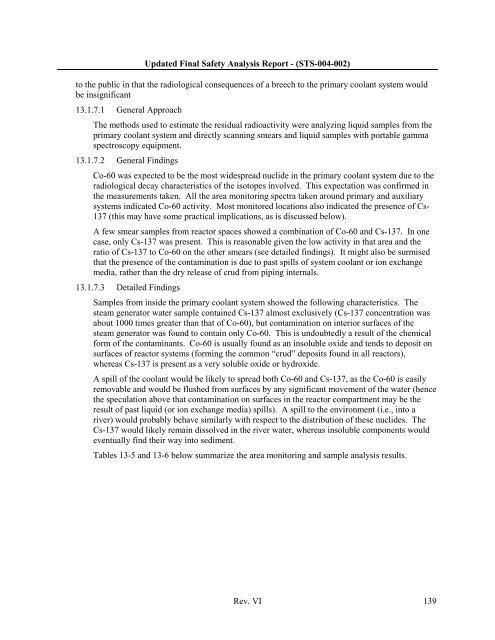10 CFR 50.71(e) - Maritime Administration - U.S. Department of ...
10 CFR 50.71(e) - Maritime Administration - U.S. Department of ...
10 CFR 50.71(e) - Maritime Administration - U.S. Department of ...
You also want an ePaper? Increase the reach of your titles
YUMPU automatically turns print PDFs into web optimized ePapers that Google loves.
Updated Final Safety Analysis Report - (STS-004-002)to the public in that the radiological consequences <strong>of</strong> a breech to the primary coolant system wouldbe insignificant13.1.7.1 General ApproachThe methods used to estimate the residual radioactivity were analyzing liquid samples from theprimary coolant system and directly scanning smears and liquid samples with portable gammaspectroscopy equipment.13.1.7.2 General FindingsCo-60 was expected to be the most widespread nuclide in the primary coolant system due to theradiological decay characteristics <strong>of</strong> the isotopes involved. This expectation was confirmed inthe measurements taken. All the area monitoring spectra taken around primary and auxiliarysystems indicated Co-60 activity. Most monitored locations also indicated the presence <strong>of</strong> Cs-137 (this may have some practical implications, as is discussed below).A few smear samples from reactor spaces showed a combination <strong>of</strong> Co-60 and Cs-137. In onecase, only Cs-137 was present. This is reasonable given the low activity in that area and theratio <strong>of</strong> Cs-137 to Co-60 on the other smears (see detailed findings). It might also be surmisedthat the presence <strong>of</strong> the contamination is due to past spills <strong>of</strong> system coolant or ion exchangemedia, rather than the dry release <strong>of</strong> crud from piping internals.13.1.7.3 Detailed FindingsSamples from inside the primary coolant system showed the following characteristics. Thesteam generator water sample contained Cs-137 almost exclusively (Cs-137 concentration wasabout <strong>10</strong>00 times greater than that <strong>of</strong> Co-60), but contamination on interior surfaces <strong>of</strong> thesteam generator was found to contain only Co-60. This is undoubtedly a result <strong>of</strong> the chemicalform <strong>of</strong> the contaminants. Co-60 is usually found as an insoluble oxide and tends to deposit onsurfaces <strong>of</strong> reactor systems (forming the common “crud” deposits found in all reactors),whereas Cs-137 is present as a very soluble oxide or hydroxide.A spill <strong>of</strong> the coolant would be likely to spread both Co-60 and Cs-137, as the Co-60 is easilyremovable and would be flushed from surfaces by any significant movement <strong>of</strong> the water (hencethe speculation above that contamination on surfaces in the reactor compartment may be theresult <strong>of</strong> past liquid (or ion exchange media) spills). A spill to the environment (i.e., into ariver) would probably behave similarly with respect to the distribution <strong>of</strong> these nuclides. TheCs-137 would likely remain dissolved in the river water, whereas insoluble components wouldeventually find their way into sediment.Tables 13-5 and 13-6 below summarize the area monitoring and sample analysis results.Rev. VI 139
















